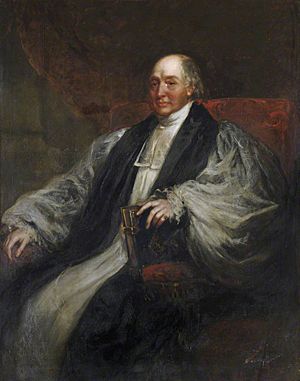James Henry Monk facts for kids
Quick facts for kids The Right Reverend James Henry Monk |
|
|---|---|
| Bishop of Gloucester and Bristol | |

James Henry Monk by Richard Buckner
|
|
| Diocese | Diocese of Gloucester and Bristol |
| In Office | 1836–1856 |
| Predecessor | Himself as Bishop of Gloucester |
| Successor | Charles Baring |
| Other posts | Dean of Peterborough (1822–1830) Bishop of Gloucester (1830–1836) |
| Personal details | |
| Born | 12 December 1784 |
| Died | 6 June 1856 (aged 71) |
| Buried | Westminster Abbey |
| Nationality | British |
| Denomination | Anglican |
| Spouse | Jane Hughes |
| Education | Norwich School Charterhouse School |
| Alma mater | Trinity College, Cambridge |
James Henry Monk (born December 12, 1784 – died June 6, 1856) was an important English church leader and a brilliant scholar of ancient Greek and Latin. He held several high positions in the Church of England, including being a bishop.
Contents
The Life of James Henry Monk
James Henry Monk was born in a town called Buntingford in Hertfordshire, England. From a young age, he showed great promise in his studies.
Early Education and University Years
He attended two well-known schools: Norwich School and Charterhouse School. After that, he went to Trinity College, Cambridge, which is a famous university. At Cambridge, he focused on studying classical languages, especially Greek.
In 1809, James Monk became the Regius Professor of Greek at Cambridge University. This was a very important job, following a famous scholar named Richard Porson. In this role, he helped create the "classical tripos." This was a new way for students to earn a degree by focusing on classical studies.
Becoming a Church Leader
James Monk also pursued a career in the church. In 1822, he was appointed Dean of Peterborough. A Dean is a senior priest who leads a cathedral.
Later, in 1830, he became the bishop of Gloucester. A bishop is a high-ranking leader in the church, overseeing many churches and priests in a specific area called a diocese. In 1836, his diocese grew even larger when it combined with the see of Bristol. This meant he became the Bishop of Gloucester and Bristol.
As a bishop, James Monk also had a role in the government. He took his seat in the House of Lords in July 1831. The House of Lords is part of the British Parliament.
James Monk's Writings and Contributions
Besides his work in the church and government, James Monk was also known for his writings. He was a respected scholar.
Famous Books and Editions
His most famous work is a book called Life of Bentley, which he published in 1830. This book was about the life of another very famous classical scholar, Richard Bentley. He also worked with C.J. Blomfield to edit a collection of notes by Richard Porson, called Adversaria, which came out in 1812.

